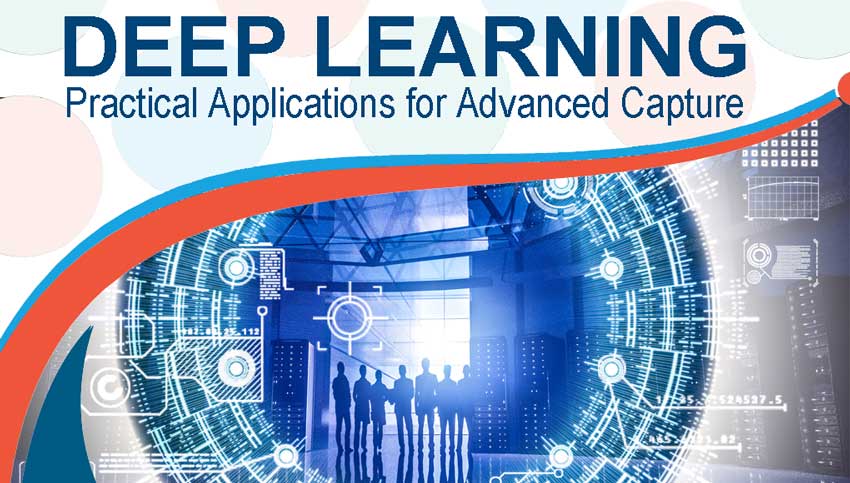
To crack open the black box of deep learning, we sat down with Bill Johnson, the VP of Global Sales at Parascript and explored the practical applications of Deep Learning. Its real impact on document automation promises to accelerate change in business processes across many industries.
R2: Deep Learning, artificial intelligence (AI) and self-learning are all hot topics. What do they mean in a practical sense?
Bill Johnson: Deep Learning is a new name for an old approach to AI. That approach is neural networks. The concept and existence of neural networks have been around for more than 70 years so the notion that machine learning and AI is new is simply inaccurate. What is new is how we apply these techniques to improve particular business processes. In the case of document capture, it has only been in recent years that advanced capture companies have embraced machine learning and AI as a method to increase their products’ capability and versatility.
R2: So what is the distinction between machine learning and deep learning?
Johnson: I’d say the difference is in the number of hidden layers that allow for tackling more complex problems with a higher degree of precision in deep learning versus machine learning. Previously, there was insufficient computing power to make application of DNNs practical. Since we have the computing power available, deep learning is actually possible.
In our case, Parascript began in the 90s by solving complex business process requirements in handwriting, cursive handwriting and pattern recognition with neural networks augmented with highly advanced machine learning algorithms and techniques. You could say, we were ahead of our time then, and we remain out front with the use of this technology today.
R2: Given that others have adopted machine learning, what does Parascript offer over other advanced capture solutions?
Johnson: Virtually all other capture products started in the form of batch capture and keying from image indexing. We essentially captured an image via a scanner and delivered it to a data entry interface where an operator would look at the screen and enter the index values from the image. Basically, advanced capture vendors eliminated the requirement to sort, match and transport the paper to the work station and all the attendant costs associated with that. It was a game changer in business process management back in the day.
Evolution of Systems
Johnson: These systems evolved as viable OCR became available over time, and automated indexing was introduced in the form of zonal data extraction. This also meant that the product code base became more complex and harder to maintain since much of the functionality was gained by integration of various components acquired or licensed through external providers.
Constrained and unconstrained handprint and handwriting remained very difficult to deal with for most vendors, and in the end, the cost to deploy was greater than value of the result due to the error rate. It was simply cheaper to key it.
Parascript solved the issues of the most difficult aspects of this process including handprint, handwriting and cursive using neural nets, AI and deep machine learning. So our clients could process complex forms more efficiently and cost effectively. We remain one of the few who can do OCR, handprint, handwriting, etc., and it’s all our own technology.
R2: Tell us about the advantage of your most recent release—Parascript FormXtra.AI—to the end user or business services provider.
Johnson: We have some incredible PhDs here who can you tell you in detail what we do and how we do it. And, our Sales team can tell you what increased performance and throughput combined with reduced error rate means in terms of ROI and capital performance, but I like to present things in terms of strategic positioning, risk mitigation and operations.
Key Measurements for Operations
Johnson: Three areas of measurement for strategic positioning, risk mitigation and operations have proven key to all our clients:
- “Time to Live” – ROI should be calculated from the time you write your first check, not when you turn the system on. If your ROI is based on “N” number of dollars saved per month, but it takes you a year to build and deploy it, you have to amortize a year’s worth of build cost into the equation. So, shortening the Time to Live period is critical to increase ROI. Parascript FormXtra.AI provides an extremely rapid Time to Live capability because there is so little manual configuration.
- Proprietary Knowledge Dependency Reduction – Most systems rely on a set of application experts to be able to deploy, maintain and support the business application. You may have only a few people supporting applications that 100s access to facilitate the business process. If you lose one of those people for any reason, you can suffer a significant reduction in force that affects that larger population of process workers. Since Parascript FormXtra.AI is largely machine-driven with regard to configuration, you don’t require specially trained people to be able to maintain it.
- Real Time Adaptability – In this ever-changing world of forms, data acquisition and business processes, the ability to adapt to a volatile environment in the shortest amount of time is critical. AI, via our deep learning capability learns and adapts to new documents and changes in forms on-the-fly. This means there is far less business interruption, training and retraining required with less drama administering the people who facilitate the process.
R2: How do these measurements relate to ROI and capital performance?
Johnson: Great Question. Shortening the Time to Live period means we start producing savings sooner against the project investment. Reduction of proprietary skill sets reduces the cost of the resource as well as the dependency on that asset. Real Time Adaptability means less business interruption both in terms of the customer/vendor experience and the time it takes to metabolize a change in process.
Think of it in terms of capital performance on a monthly basis. If you amortized the project cost to a monthly investment and compared that to the savings the system provides, you can arrive at a monthly ROI. In fact, you can now think of it in terms of retained earnings as the system is now generating cash flow.
R2: Beyond just a hot topic and applied to advanced capture, how do you think deep learning will impact us?
Johnson: Deep learning or neural networks requires people like we have here at Parascript who know how to train systems to get more efficient, higher quality and precise results. It’s a very different skill than just plugging in open source algorithms or building the next app. It requires new talent, and also preparing and educating each of us in AI, its strengths and its current limitations as we see AI begin to impact all of our lives.
###
If you found this article interesting, you might find this webinar on digital transformation useful:




